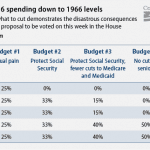This article first appeared at americanprogress.org
The American people reacted with horror after Republicans in the House of Representatives passed their budget plan this past spring to eliminate Medicare as we know it, decimate Medicaid, and slash education, transportation, and scientific research funding down to unprecedented levels. With the din of disapproval ringing in their ears, conservatives changed tactics. This week the House will vote on a proposal to cap federal spending at 18 percent of gross domestic product, the broadest measure of our economy.
 This proposal might sound good in a press release. And it certainly allows its supporters to avoid calling for specific cuts to popular programs. But capping federal spending at 18 percent of GDP—a level not seen in half a century—would actually require cuts that are even larger than those in the original House Republican budget plan.
This proposal might sound good in a press release. And it certainly allows its supporters to avoid calling for specific cuts to popular programs. But capping federal spending at 18 percent of GDP—a level not seen in half a century—would actually require cuts that are even larger than those in the original House Republican budget plan.
The last time federal spending dipped below 18 percent of GDP was 1966. Back then there were 100 million fewer people living in the United States, the median age was nearly eight years younger, and the average cost of health care was one-fifth of what it is now. In fact, no president in the last 50 years ever proposed a budget that would bring spending that low. President Reagan’s budget proposals never dropped below 21 percent of GDP, and actual spending under Reagan averaged over 22 percent. Even the budget passed by the Republican-led House, with all its draconian cuts to Medicare and Medicaid, keeps spending above 18 percent of GDP for the next 30 years.
So what would it take to bring spending to such an unrealistically low level? Of course, there are lots of different ways Congress could try to accomplish that goal. It could focus most of the cuts in one area or another, and try to protect this program or that. But it turns out that the level of cuts required is so dramatic, so draconian, that any way you slice it, Congress would end up making severe cuts to some very important programs.
In 2016, for example, we estimate that total federal spending is likely to be around $4.4 trillion, or 22.9 percent of GDP, based on Congressional Budget Office March 2011 projections. Our spending projection makes two adjustments to CBO’s official estimates. First, we assume defense spending will follow President Obama’s proposed levels rather than CBO’s levels because CBO’s projections of defense spending do not account for a drawdown in Iraq and Afghanistan. Second, our spending projections include a so-called “doc fix,” meaning Congress will not allow the very large cuts to Medicare doctors required by the so-called Sustainable Growth Rate formula.
Of that $4.4 trillion in 2016, about $520 billion will be interest payments on the debt—an area Congress can’t directly cut. That leaves about $3.9 trillion in noninterest spending, from which Congress would have to slash about $1 trillion in order to bring total spending down to 18 percent of GDP. This would require a 25 percent cut to everything in the federal budget—from Social Security to veterans’ benefits to the Pentagon to education. Congress could try to protect some programs from such severe reductions but then, of course, other areas would have to be slashed even more.
The accompanying table provides some illustrative examples for how federal spending could be slashed in order to meet an 18 percent cap in 2016. The first budget spreads the cuts around equally—cutting everything by 25 percent. The next three budgets protect Social Security and cut less from Medicare and Medicaid, which means they also cut far more from everything else. And the final budget shows the cuts that would be necessary if Congress wanted to protect the Pentagon as well as seniors from truly devastating cuts.

None of these options is particularly realistic. Take Budget No. 2. Conservatives are promising that their 18 percent cap won’t hit Social Security. But if they exempt Social Security benefits from cuts, then they’ll need to slash everything else, including Medicare and Medicaid, by a third. If they try to keep the Medicare and Medicaid cuts down to 15 percent, which would still be devastating, they’ll be forced to cut the rest, including defense, by 40 percent.
The country is simply not going to stand for massive cuts to Social Security, Medicare, and Medicaid—cuts that would fundamentally undermine the purpose and efficiency of these programs. And while we absolutely should find savings in the defense budget, few would support cuts on the order of 40 percent to 50 percent. But even if we subject those areas to smaller reductions, that would force us to cut everything else by two-thirds. Does anyone truly believe the country would be better off with two-thirds fewer food safety inspectors, two-thirds less funding for education, and two-thirds fewer dollars for the maintenance of roads and bridges?
There is no way around the basic arithmetic. The only way to achieve that level of spending is by radically altering some fundamental public programs and services. A federal spending cap may sound innocuous but it is simply massive cuts to Social Security, Medicare, and Medicaid by another name.
By Michael Linden Y Michael Ettlinger



[…] […]